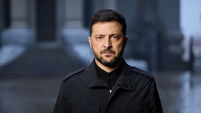Dogs of war: Cartoon characters are taking the fight to Russia

Cartoon dogs hounded a senior Russian diplomat from social media, many tweeting Shiba Inus being Irish.
That was until an army of cartoon Shiba Inu dogs came for him on X (formerly known as Twitter).
After Russia launched its full-scale invasion of Ukraine in February 2022, in a conflict that started with its military occupation of Ukraine’s Crimean Peninsula and parts of the Donbas region on the mainland in 2014, Ulyanov had been full-throated on Twitter in support of the war. He regularly lambasted Ukraine’s leadership and called for ‘no mercy for the Ukrainian population!’ This brought him to the attention of the Shiba Inus.

They poured into his comments and replies in droves, mocking him, making memes about him, and pulling apart his justifications for apparently supporting genocide. Ulyanov’s frustrated reply became legend.
“You pronounced this nonsense, not me,” Ulyanov said, before disappearing from the platform.
The cartoon dogs, or, as they branded themselves, the North Atlantic Fella Organization, or NAFO, had gained their first slogan and hounded a senior Russian diplomat from social media. And many of Shiba Inus tweeting at him were Irish.
NAFO emerged from a diverse group of people on X who supported Ukraine, and who had spent much of their time on the platform attempting to counter Russian propaganda with ‘shitposting,’ or making memes that mocked and disrupted the work of Russian propagandists. This began at the start of the war in February 2022, and in the coming months, these online activists increasingly combined their efforts.
The group began to coalesce into something more cohesive in May 2022 when Polish artist Kamil Dyszewski started creating modified Shiba Inu dogs, grafting their heads onto a tracksuit figure with hands in pockets, and a wide stance, for members of NAFO, who are known as ‘fellas.’

He chose the dog as it was a pervasive, accessible image online, and because “it was so dumb, it was funny.”
Soon he was creating custom designs of fellas in exchange for donations to the Georgian Legion, a unit of the Ukrainian army composed primarily of volunteers from Georgia.
The army of Shiba Inus began to increase exponentially, with ever-more unusual takes on the original template. There were fellas with highland kilts and traditional Irish clothing, punk motifs, and medieval wenches, mods and rockers, military uniforms, and much more.
“NAFO is such a diverse conglomerate of people, from different walks of life, that it is impossible to describe. From clerks, activists, veterans, and active duty soldiers, to academics, medical practitioners, scientists, and politicians; we’ve got it all,” Dyszewski said.
Justin Moorhead is one of this motley crew. The 41-year-old from Louth had no history of activism before the full-scale invasion of Ukraine by Russia began, aside from conversations with his friends and acquaintances in favour of repealing the Eighth Amendment. While every member of NAFO is motivated to support Ukraine, the reasons for their support are often diverse. Moorehead, for one, saw parallels between Ukrainian and Irish history.
“When we sought independence from British rule, the Irish usually received help from our allies on the continent. We often came close to victory but as our allies usually didn’t commit fully, the Irish/allies nearly always lost,” Moorhead said.
“Ukraine must ensure it forces its allies to commit fully and it will win. I think Ukraine is doing this, but more must be done. Unlike our treaties with the UK, which were real and positive steps forward, Russia only negotiates a settlement to buy time so it can rebuild militarily.”
Moorhead believes it’s not just up to nation states and NGOs to stand with Ukraine; in the democratised information sphere created by social media, individuals can play their part too.
The tactics used by NAFO to fight for Ukraine on this front are many-fold, ranging from the aforementioned sharing of memes to declaring “article 5". This is when hundreds of them will report accounts en masse for breaking the site’s terms of service by glorifying or supporting genocide, something pro-Russian accounts have become infamous for.
For NAFO this serves an important purpose as suppressing disinformation about the war helps ensure that Ukrainian voices can be heard accurately on a global platform. In a war characterised by the extreme brutality of Russian soldiers, including murder, the rape and castration of Ukrainian POWs, and the abduction of children, ‘shitposting’ can do a lot to raise morale.
“During the Russian summer campaign, every fella was affected by watching the brutal artillery strikes. We understood what was happening on the frontlines. We understood the suffering that Ukraine endured. But in the midst of all this mental suffering, NAFO was pounding vatniks and we were all laughing,” Moorhead said.
The term vatnik is commonly used by Ukrainians and their supporters to describe the slavishly pro-Putin, pro-Russian supporters of the invasion. This applies to Russians as well as their international supporters, who in the vast majority of cases come from the political far-left or far-right. The Venn diagram of Russia’s supporters, anti-establishment conspiracy theorists, and the politically extreme is frequently a circle.
NAFO’s members also have a shared dislike for Russian apologists is intense, but it also sometimes extends to those Russians who claim they’re against Putin’s regime. The collective organised a conference in Vilnius, Lithuania, in July this year, the “NAFO Summit,” which was even attended by officials from Baltic state governments and NGOs.
Controversy erupted when one attendee was spotted with an inflatable shark, apparently a reference to a Russian tourist who had recently been attacked and killed by one in Egypt.
Supporters of jailed Russian opposition leader Alexey Navalny took to X to voice their outrage. Fellas piled in in response, swamping the Russian activists’ social media pages with memes and comments about how silent the Russian opposition had been regarding their country’s war crimes in Ukraine, their refusal to condemn the Russian army, and their tacit support of the annexation of Crimea, as well as pointing out Navalny’s own history of making racist comments. There is no love lost between the groups.
NAFO’s membership is always keen to point out that the Russians have committed numerous war crimes almost unopposed for decades, In Chechnya, Georgia, Syria, and now Ukraine. They say Russia’s so-called opposition, like Navalny, and Western governments have been silent on Russian army atrocities for too long.

They believe that in the defence of freedom, no meme or joke is too harsh, and point to their work on exposing Russia’s war crimes.
NAFO was instrumental in spreading visual proof of the Bucha massacre and other incidents in Ukraine, and even when the current war is over, they plan to still hold Russia to account.
“We helped make sure that for the first time in many years, the Russians had to fold their propaganda circus and accept defeat — right after the Bucha massacre. Up until that point Russians, killed, maimed, and brutalised civilians across the globe. They did so with no opposition because their propaganda machine always managed to shift the blame,” said Dyszewski, when asked what made him proud of helping to launch NAFO.
“The ultimate goal is to support Ukraine in its struggle for freedom. I can only hope that NAFO will continue to do so until the very last millimetre of not just Ukrainian land is free, but all the other countries that have suffered under its rule.”
Until that day, the Shiba Inus will continue their work, and Russian diplomats will be hesitant to log on to X.
- Andrew Sweeney is a freelance journalist

















